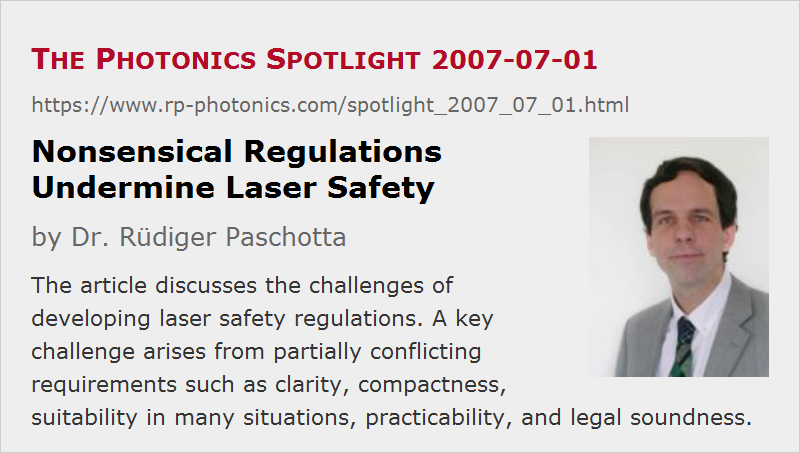Nonsensical Regulations Undermine Laser Safety
Posted on 2007-07-01 as a part of the Photonics Spotlight (available as e-mail newsletter!)
Permanent link: https://www.rp-photonics.com/spotlight_2007_07_01.html
Author: Dr. Rüdiger Paschotta, RP Photonics Consulting GmbH
Abstract: The article discusses the challenges of developing laser safety regulations. A key challenge arises from partially conflicting requirements such as clarity, compactness, suitability in many situations, practicability, and legal soundness.

Ref.: encyclopedia article on laser safety
What is the purpose of laser safety regulations? Obviously they should help to substantially decrease the risk of accidents. However, they also have legal implications: when it comes to an accident, it will be legally relevant whether adequate regulations were in place, whether people were informed about them, and whether or not the regulations were observed. Unfortunately, this dual function of safety regulations creates a conflict of goals. If not properly handled, this can have effects which in the end undermine laser safety.
Imagine that you are the one who has to formulate the safety regulations. Definitely, you want them to avoid accidents. But also you want to be in safe position if something bad happens anyway. So you might be inclined to formulate the rules so that you are legally “on the safe side”, even if you have doubts whether the implied restrictions make sense in all cases and will be compatible with all the other needs of the workers or researchers – getting results, for example. What is actually needed is a set of regulations meeting a number of partially conflicting requirements:
- Regulations must be clear and understandable for those reading them.
- The rules should be sensible, ideally under all conceivable circumstances: the implied restrictions should be so that all risks are minimized without being in straight conflict with the actual goals of the work.
- The set of rules should be compact, so that one can expect people to read them carefully.
But what is needed to be just legally in a safe position is much less: essentially it might be sufficient to reach clarity and ban everything which might be dangerous – whether this will be practical or not.
If regulations really focus on these legal aspects while ignoring others – which seems to happen quite frequently – the results can be worrying. Assuming that the regulations are strictly observed, the productivity of the work can be unnecessarily reduced. However, the result is more likely that people will break the rules – first in exceptional cases only, later on perhaps even routinely. In the worst case, safety regulations are then perceived as cumbersome, annoying, useless – in other words, as something directed against those working with them, rather than something helping them to reach all their goals, including both safety and productivity. (I am ignoring cases where productivity does not belong the goals …) It is likely then that any useful content of the regulations is overlooked as well, and the motivation to properly deal with safety issues can be undermined.
So if one really wants to minimize risks while maintaining the productivity, one has a challenging task. Some compromises between all the different goals (e.g. simplicity and being suitable for most situations) are inevitable, but a serious effort, based on a careful analysis of the concrete situation, can surely lead to better compromises. Finally, everyone should be aware of that challenge and appreciate the value of even not yet perfect solutions.
This article is a posting of the Photonics Spotlight, authored by Dr. Rüdiger Paschotta. You may link to this page and cite it, because its location is permanent. See also the RP Photonics Encyclopedia.
Note that you can also receive the articles in the form of a newsletter or with an RSS feed.
Questions and Comments from Users
Here you can submit questions and comments. As far as they get accepted by the author, they will appear above this paragraph together with the author’s answer. The author will decide on acceptance based on certain criteria. Essentially, the issue must be of sufficiently broad interest.
Please do not enter personal data here; we would otherwise delete it soon. (See also our privacy declaration.) If you wish to receive personal feedback or consultancy from the author, please contact him e.g. via e-mail.
By submitting the information, you give your consent to the potential publication of your inputs on our website according to our rules. (If you later retract your consent, we will delete those inputs.) As your inputs are first reviewed by the author, they may be published with some delay.
 |



If you like this page, please share the link with your friends and colleagues, e.g. via social media:
These sharing buttons are implemented in a privacy-friendly way!